Colorful ‘Wicked’ explores Oz backstory, falling short
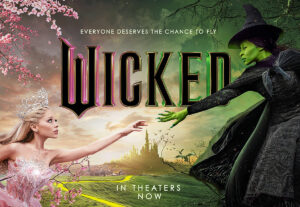 By Steve Crum
By Steve Crum
Although box office heralded, Wicked is troublesome as well as wondersome. At this writing, Wicked (aka Wicked: Part I) has just been Oscar nominated in multiple categories, including Best Picture. So what is “troublesome” about the movie? The screenplay alone is such. Winnie Holzman and Dana Fox have adapted the original, Tony winning Broadway production—also by Holzman, along with 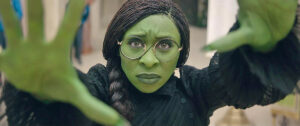 Stephen Schwartz and Gregory Maguire. (I have to confess that I have never seen the stage version.)
Stephen Schwartz and Gregory Maguire. (I have to confess that I have never seen the stage version.)
So what’s not to love about the 160-minute (it seems longer) Wicked movie? Although its co-star, Cynthia Erivo (who plays the green-skinned Elohaba Thropp/Wicked Witch of the West) is a talented singer, there is not one song she sings that is hummable enough to hum—let’s say—in the shower. 1939’s The Wizard of Oz, however, is packed with songs that are still sung today. OK, times have changed over the last 85 years. But Harold Arlen and Yip Harburg (The Wizard of Oz) created wonderful songs with MELODY.
Wicked’s Stephen Schwartz writes songs absent of substantial melody. He has only gotten worse at this since his days of composing music for Godspell and Pippin. Then again, recent Broadway and movie musicals can be accused of the same thing. Alas, the days of memorable songs by Irving Berlin, Cole Porter, and Rodgers & Hammerstein are ancient history.

We have what we have now, and are excited to lower the musical bar and jump to a standing ovation. I’m not among that audience, but many/most are. Consider me a grain of salt.
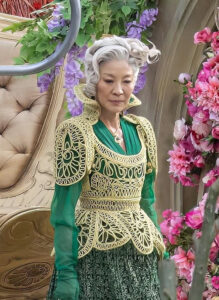 Wicked has zero music and lyrics to even slightly compare with “Over the Rainbow” and “We’re Off to See the Wizard” from The Wizard of Oz.
Wicked has zero music and lyrics to even slightly compare with “Over the Rainbow” and “We’re Off to See the Wizard” from The Wizard of Oz.
My justification for spending so much time criticizing Wicked’s songs is a given: IT’S A MUSICAL! Call me both a fuddy and a duddy.
HOWEVER, there is still much to like about Wicked. The music is passable, but the visuals are awesome. It’s no spoiler to point out that the title itself is a giveaway. Assuming everyone has seen The Wizard of Oz, Wicked centers on the backstory of its scary, green-skinned, magical mistress of evil aka “The Wicked Witch.” HINT: She was not born evil. The story, told through flashbacks within flashbacks, follows the turn in her personality.
That flashback within flashback technique can be off-putting since it is sometimes confusing due to the non-linear storytelling.
 But the cast is stellar. In addition to Erivo, there are Ariana Grande (Glinda), Jonathan Bailey (Fiyero Tigelaar), Ethan Slater (Boq Woodsman), Michelle Yeoh (Madame Morrible), and Jeff Goldblum (The Wonderful Wizard of Oz).
But the cast is stellar. In addition to Erivo, there are Ariana Grande (Glinda), Jonathan Bailey (Fiyero Tigelaar), Ethan Slater (Boq Woodsman), Michelle Yeoh (Madame Morrible), and Jeff Goldblum (The Wonderful Wizard of Oz).
There is also a very cool surprise featuring two cameos by way of Broadway!
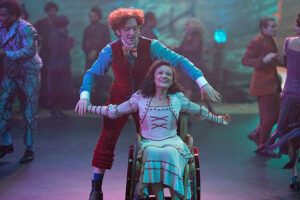 The overall production is glitzy, packed with singers and dancers in wowser costumes, hair and makeup. Set design highlights include the Wizard’s domain plus a training academy reminiscent of Harry Potter’s Hogwarts. (Love that rotating library!)
The overall production is glitzy, packed with singers and dancers in wowser costumes, hair and makeup. Set design highlights include the Wizard’s domain plus a training academy reminiscent of Harry Potter’s Hogwarts. (Love that rotating library!)
Perhaps most of all visual treats, we witness the origin of the evil Flying Monkeys.
Jon M. Chu (Crazy Rich Asians) impressively directs an elephantine production that succeeds despite lacking a score that could have made Wicked memorable for decades—even without Judy Garland.
—————
GRADE on an A-F Scale: B-
__________
The sequel, Wicked: For Good, which will cover the events of the musical’s second act, is scheduled for release on November 21, 2025.
Penny ‘Blondie’ Singleton had well-lived showbiz, service life
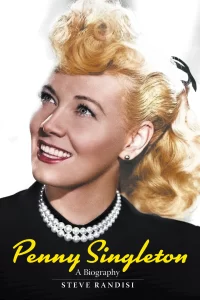 By Steve Crum
By Steve Crum
Had Steve Randisi written a loving book about an actress who appeared in a long-running series of 28 films, that accomplishment alone would be worthy of a major write. But it so happens his fascinating biography of Penny Singleton encompasses an actress, activist, wife and parent who entertained stage, screen, radio and TV audiences…and served as a labor union leader during her 95 years.
Penny Singleton: A Biography is a relatively fast read for its 325 pages, and made informative and interesting by Randisi’s obvious 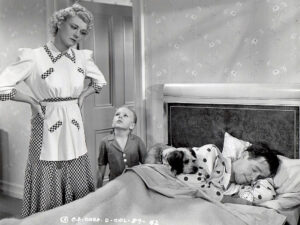 research and adoration of his subject.
research and adoration of his subject.
Born Dorothy McNulty, Penny Singleton (1908-2003) aspired to be an entertainer. Winning the $5 first prize in a Philadelphia amateur talent contest in 1916 did much to encourage the eight year-old. (She sang My Gal Sal.)
From this seemingly Hollywood-movie start through “The Final Years” of the book’s Chapter 22, the book covers her journey from singing at a silent movie theater to singing and dancing in a vaudeville act with none other than Milton Berle, a childhood friend. (By the way, Penny’s dancing style is described as very athletic/gymnastic.) Her play dates rose to parts in Broadway productions and touring in nightclubs and roadshows of plays—akin do what would later be called summer stock.
Randisi’s descriptions of her auditions include her hopes and frustrations. She started getting bit parts in motion pictures, which led to her being cast as Blondie Bumstead (based upon Chic Young’s newspaper comic strip) in the feature comedy, Blondie, in 1938. The low budget programmer was a super hit for Columbia 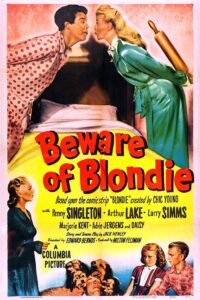 Pictures, which was followed by 27 more Blondie movies co-starring Arthur Lake as Dagwood. The Blondies ended in 1950.
Pictures, which was followed by 27 more Blondie movies co-starring Arthur Lake as Dagwood. The Blondies ended in 1950.
Incidentally, she had long since changed her stage name from Dorothy McNulty. (That interesting factoid is covered in the book as well.)
The second half of her life was filled with more work: a Blondie radio series, her own variety radio program, The Penny Singleton Show, and a fun musical comedy movie, Go West, Young Lady.
The book’s final chapters cover Penny’s leadership as a very vocal and effective President of the American Guild of Variety Artists. 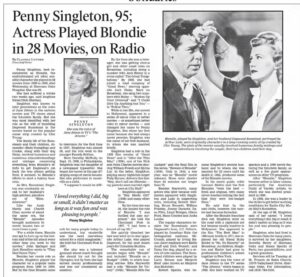 By this time, show business had given way to her union duties as well as her family. (She does return to TV doing voice work in a significant animated series.)
By this time, show business had given way to her union duties as well as her family. (She does return to TV doing voice work in a significant animated series.)
Steve Randisi’s research includes talks he had with Penny decades ago. Interviews with Penny’s family, friends and co-stars help the reader humanize this talented, good-hearted lady.
Let me add how appreciative I am that Steve includes capsule descriptions of the Blondie movies. That alone could have been extended into a second volume.
==========
Penny Singleton: A Biography by Steve Randisi; c. 2024, BearManor Media.
Dystopian ‘Civil War’ is spectacularly ominous
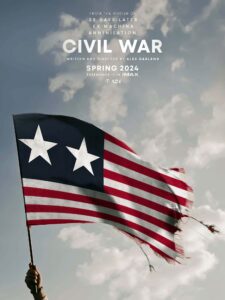 By Steve Crum
By Steve Crum
Alex Garland’s Civil War is described as a “dystopian action thriller,” which it is and maybe isn’t. Being an action thriller is definitely true. The dystopian moniker is iffy because the plot line straddles the line between what is or could be reality and fantasy. For years, there have been suggestions and threats of states seceding and declaring a war against the rest of the United States.
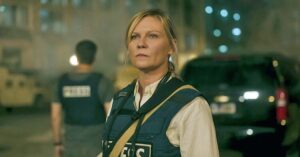 That nightmarish thought is played out in Civil War. Maybe labeling it a dystopian horror story is more apt. Factor in sad, pitiful and disgusting.
That nightmarish thought is played out in Civil War. Maybe labeling it a dystopian horror story is more apt. Factor in sad, pitiful and disgusting.
Don’t get me wrong. The professional quality of the film itself is not sad, pitiful and disgusting. But its representation definitely is such. Alex Garland impressively guides a fine cast (Kirsten Dunst, Wagner Moura, Stephen McKinley Henderson and Cailee Spaeny), cinematographer Rob Hardy, and editor Jake Roberts in this telling of what might happen if.
Crucial to its believability is a heavy reliance on digital special effects and/or AI—if there is indeed a difference.
 Garland’s story follows a small group of journalists driving across the United States, often through battle zones (tanks, fighter planes, bombs, rifles), to reach their goal of interviewing the controversial President (Nick Offerman) before rebel forces led by California and Texas beat them to our Capitol to kill him. Along the way the four risk their lives by snapping still photos (via 35 mm cameras?) to recount the destruction and body count at ongoing battle sites. (In this sense, the time seems to be set during the 1970s. Otherwise, why don’t they carry video or digital film cameras?)
Garland’s story follows a small group of journalists driving across the United States, often through battle zones (tanks, fighter planes, bombs, rifles), to reach their goal of interviewing the controversial President (Nick Offerman) before rebel forces led by California and Texas beat them to our Capitol to kill him. Along the way the four risk their lives by snapping still photos (via 35 mm cameras?) to recount the destruction and body count at ongoing battle sites. (In this sense, the time seems to be set during the 1970s. Otherwise, why don’t they carry video or digital film cameras?)
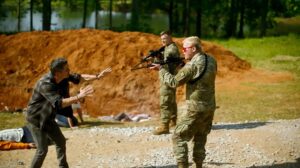 The photojournalists are Lee Smith (Dunst), Joel (Moura), Jessie (Spaeny), and Sammy (Henderson). The four actors do great ensemble work. Throughout most of the literally war-torn journey from New York City to Washington D. C., they travel by well-used car labeled PRESS on its hood. Along the trek, they encounter pockets of individual and group activists from both sides.
The photojournalists are Lee Smith (Dunst), Joel (Moura), Jessie (Spaeny), and Sammy (Henderson). The four actors do great ensemble work. Throughout most of the literally war-torn journey from New York City to Washington D. C., they travel by well-used car labeled PRESS on its hood. Along the trek, they encounter pockets of individual and group activists from both sides.
Particularly jarring is a sequence of a handful of soldiers executing citizens they perceive as enemies, and then dropping their bodies into a mass 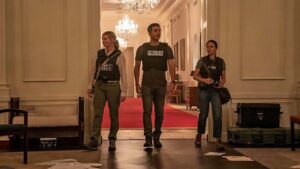 grave. The journalists find themselves directly in the middle of said mess, which escalates into tragedy. (Continued when you see the movie, folks.)
grave. The journalists find themselves directly in the middle of said mess, which escalates into tragedy. (Continued when you see the movie, folks.)
Via the dictionary, “fear, distress, and oppressive societal control” describe dystopian. Strictly speaking then, Civil War fits the grim bill.
—————
GRADE on an A-F Scale: B+
Complex ‘Emilia Pérez’ stuns with brilliant acting, writing
 By Steve Crum
By Steve Crum
Originality is Emilia Pérez. Just sum up this mind boggling Jacques Audiard masterpiece. Audiard produced, directed and wrote both the screenplay and the opera libretto it is based upon. (It is also adapted from Boris Razon’s novel, Écoute.)
Describing EP as a musical crime comedy might sound odd, but so be it. Its 132-minutes weave from gangster drama and violence to love story 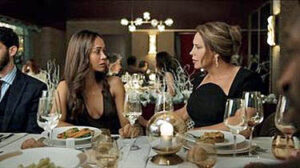 to song and dance sequences. The blend may be jaw dropping, but it all seems right.
to song and dance sequences. The blend may be jaw dropping, but it all seems right.
Vaguely reminiscent of 1992’s The Crying Game, written and directed by Neil Jordan, EP follows a unique plot line that is much more complex. Realize too that the lead character in Emilia is a transgender cartel boss…played by the transgender actress Karla Sofia Gascón! Score another uniqueness point for originality.
Factor in that before he has “gender affirming surgery,” Emilia is known as Juan “Manitas” Del Monte, married to Jessi (well played by Selena Gomez) and father of their two children. In hoodlum parlance, Jessi is on the lamb from enemies. He wishes to appear killed—by going into hiding and undergoing a body and identify makeover— to protect his family.  Even his wife is unaware, and mourns his “death.”
Even his wife is unaware, and mourns his “death.”
At the outset of the plan, (then) Juan persuades a so-so but talented Mexican attorney to handle his affairs during the upcoming transition—that is filled with complications. Zoe Saldaña plays Rita Mora Castro, who does terrific work from dramatics to singing and dancing when the story segues into near opera. Equally stunning is the music composed by Clément Ducal (score) and Camille (songs).
That Emilia not only misses her wife and kids, but decides to push her charade to actually move in with them disguised as Juan’s  sister…is enough of too much reveal.
sister…is enough of too much reveal.
Here is an amazing motion picture, truly original.
—————
GRADE on an A-F Scale: A
‘Horizon’ is majestic in scope, but major disappointment
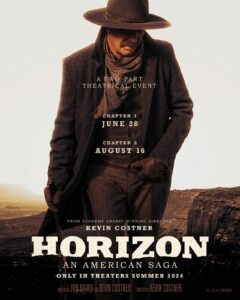 By Steve Crum
By Steve Crum
Kevin Costner’s epic western, Horizon, should have been better. It saddens me to say such because I am both a huge fan of the western genre plus a Costner fan. His Dances With Wolves remains an all-time classic.
But now comes Horizon.
Horizon, officially titled Horizon: An American Saga—Chapter 1, is a sprawling (in the true sense) 181-minutes. To be fair, it is difficult to judge the film since it is only 1/4 of the whole story. Yes, there are four, count-em, parts—three yet to be released. Although there are some interesting set pieces in this first chapter, like dissent among the Apaches and lawlessness among the Whites, this Horizon is a character study setting up future developments in plot.
One can only imagine the progression of plot among the multitude of characters introduced. Among them is, of course, Kevin Costner, who produced, co-wrote, directed and stars. His Hayes Ellison is a Montana 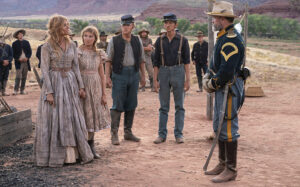 territory horse trader who gets mixed up with a prostitute and murder.
territory horse trader who gets mixed up with a prostitute and murder.
Others in the basic cast of 40+ include Sienna Miller, Sam Worthington, Giovani Ribisi and Michael Rooker.
The storyline centers on Westward migration during 1859 in the Arizona Territory. Handbills advertise settlement in the newly established town of Horizon. Homesteaders are enticed to settle, 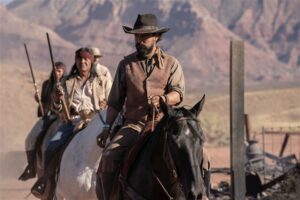 despite opposition of opposing Apaches. Of course, the impending danger of such is definitely not mentioned on any advertising circulars. Fast forward to 1863 with the basically tent city burg of Horizon celebrating their new land as Native Americans making armed opposition. A graphic slaughter of men, women and children ensues.
despite opposition of opposing Apaches. Of course, the impending danger of such is definitely not mentioned on any advertising circulars. Fast forward to 1863 with the basically tent city burg of Horizon celebrating their new land as Native Americans making armed opposition. A graphic slaughter of men, women and children ensues.
What follows is retaliation by the cavalry stationed at nearby Camp Gallant as well as greedy, scalp hunting ruffians. The story develops into romances and jealousy at the fort. Cut to Montana violence, life in a railroad work camp, a Santa Fe Trail wagon train, and relentless revenge against Native Americans.
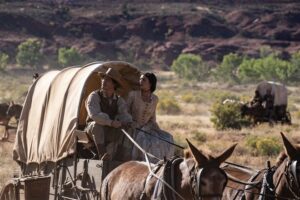 The aforementioned plot lines have been covered in many aspects since the beginning of the western genre. Costner has emphasized realism and in depth characters in his telling. I really like Costner touches like peering out of a distorted glass window—realistic for that time. In a similar vein, part of a gunfight is via the reflection in a water trough.
The aforementioned plot lines have been covered in many aspects since the beginning of the western genre. Costner has emphasized realism and in depth characters in his telling. I really like Costner touches like peering out of a distorted glass window—realistic for that time. In a similar vein, part of a gunfight is via the reflection in a water trough.
Costner is impressive, as are J. Michael Muro’s cinematography and John Debney’s score. Acting 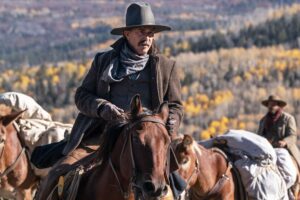 overall is exemplary.
overall is exemplary.
The picture ends with collage snippets of scenes in the upcoming Horizon—Chapter 2.
Although Chapter 1 pretty much failed at the box office, much to Costner’s and my chagrin, the second part is indeed planned for a 2025 theatrical release.
—————
GRADE on an A-F Scale: C+
